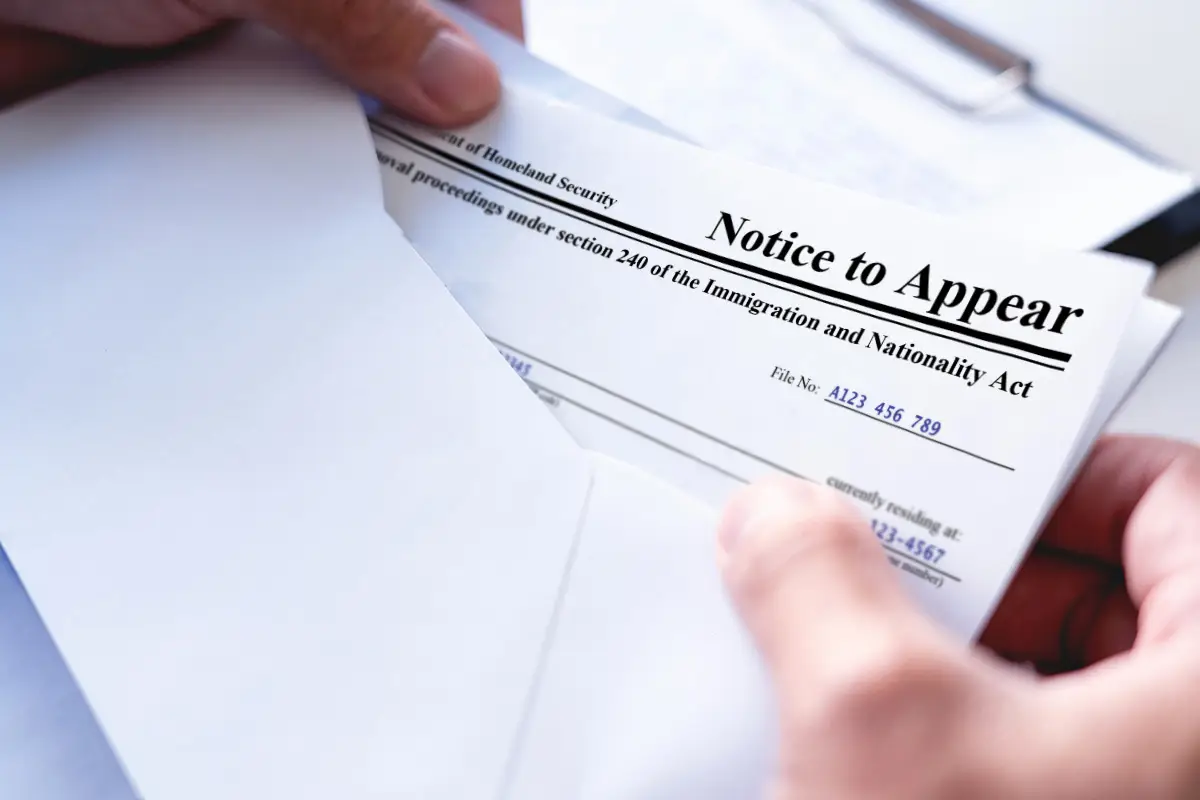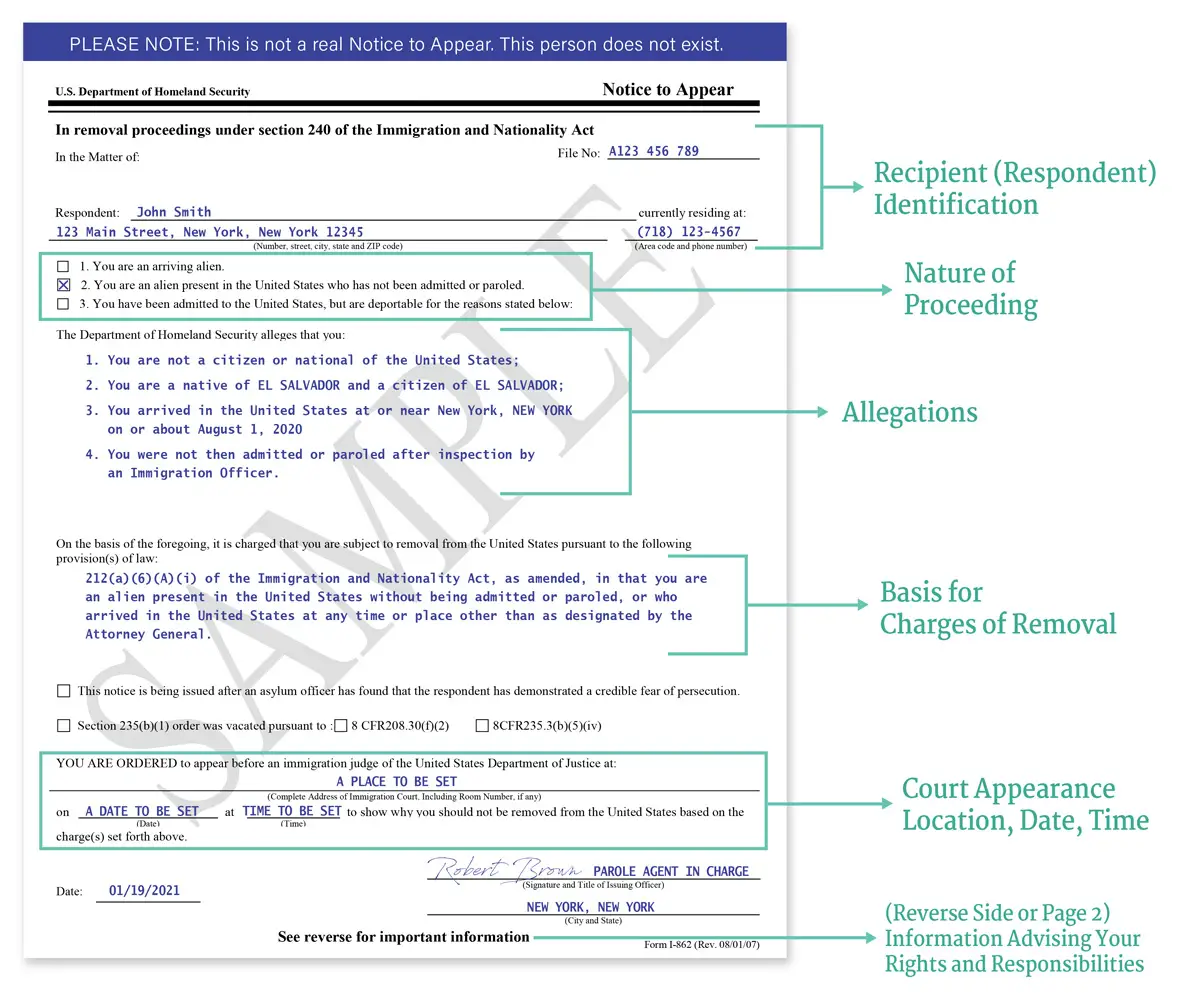

A Notice to Appear can be a very scary piece of mail to receive — especially if you don’t know what it means or what to do about it! This official document instructs you to appear in immigration court before a judge. It is the first step in initiating removal proceedings against you and a path to potential deportation from the United States. These proceedings officially commence when the DHS also files the NTA with the immigration court.
The NTA may be served to you personally or mailed to your last known address or to your attorney, if you have one. The general purpose of the NTA is to list the allegations for charges laid against you by the DHS as grounds for removal. It will include:
The image below of an example NTA document shows how the letter is formatted, and where to look for all the different sections of information contained.

This section of the NTA document will inform you as to which general immigration charge or status applies to you. There are 3 statement options:
Make sure the correct box is marked that applies to you. A newly arriving alien or persons who have entered the US without being admitted or paroled will have fewer opportunities to challenge the deportation proceedings than someone who entered lawfully. A licensed attorney that specialized in immigration law can help you determine what options you have.
In this section the DHS will list the factual allegations they have against the respondent (the recipient of the NTA) that establish them as an alien. This will include their country of birth and/or nationality, details regarding when/where they entered the US, and other facts that may support a reason for removal. Be sure to check this section thoroughly for any information that may be inaccurate or incomplete. An attorney can help you determine what legal challenges can be made against the NTA and removal proceedings.
The basis for removal will reference a specific section of the Immigration and Nationality Act (INA) that was violated depending on the nature of proceedings and allegations. This is the legal reason why you can potentially be deported from the United States. Depending on the charges, you may be eligible for immigration relief, but you must apply by a deadline set by the Immigration Court. An attorney can help you determine your eligibility and complete all steps necessary.
The bottom of the NTA may list information regarding the first court hearing. If it does not and the spaces read “to be determined” or “to be set”, then you will receive a “Notice of Hearing” separately from the Immigration Court. The NTA with specific court hearing information OR a Notice of Hearing must be served to the respondent at least 10 days prior to the date of any scheduled hearing. There is an option to bypass the ten-day waiting period if the respondent desires, which can be beneficial when being held in custody of immigration officials.
It is very important to pay attention to all information regarding your hearing to make sure you do not miss it. Respondents who fail to appear at their designated hearings can be deported without the opportunity to defend themselves.
The purpose of the Immigration Court hearings is for the respondent to present their side against the allegations and charges laid out in the NTA. Afterwards, the Immigration Judge will make a decision on one or more of the following:
On the back or second page of the NTA letter, there will be a section advising the respondent of their rights and responsibilities throughout the removal proceedings, and will list several legal warnings. These include:
The final item which will be included with your Notice to Appear will be a Certificate of Service detailing how and when the DHS issued the NTA. It is important to check this document as well to make sure it is factual and correct to the manner in which you received the NTA. Any mistakes or errors you find may help in your case against deportation. An experience immigration attorney can help you determine what options you have and the best way to combat the proceedings.
After you’ve received a notice to appear, you should:
U.S. immigration law is incredibly complex and when facing a Notice to Appear a good lawyer is a worthwhile investment for your well-being, for your family, and for your future. In many cases, hiring an attorney saves you time, aggravation, and even money! Laird Law, headquartered in New York City, with offices in Manhattan and New Jersey, specializes in immigration law. If you’ve received a Notice to Appear or need legal assistance with any other immigration services, contact us today!